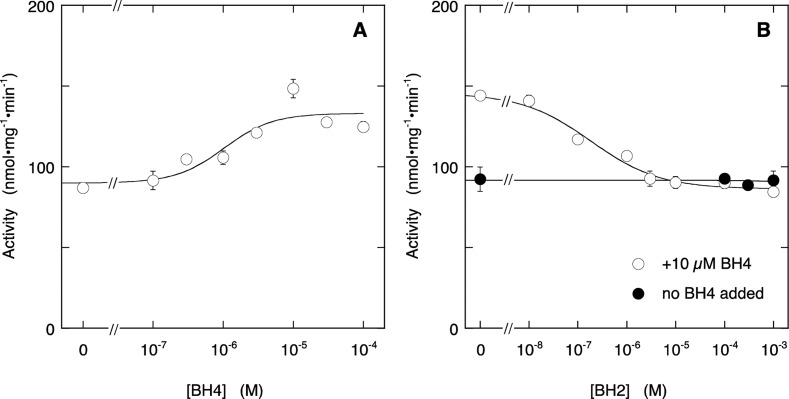Figure 3.
Effect of BH4 (A) and BH2 (B) on NO production by ECo-nNOS after overnight incubation with BH4. Panel A shows the stimulation by BH4 of NO formation, measured with the oxyHb assay. The curve through the data is the best fit to the Hill equation with fitting parameters EC50 = (1.0 ± 0.9) × 10–6 M, Act0 = 90 ± 10 nmol·mg–1·min–1, Act∞ = 133 ± 8 nmol·mg–1·min–1, h = 1.3 ± 1.2. Panel B shows the inhibition by BH2 in the absence (closed symbols) and presence (open symbols) of 10 μM BH4. The curve through the data in the presence of BH4 is the best fit to the Hill equation with fitting parameters IC50 = (1.8 ± 1.0) × 10–7 M, Act0 = 146 ± 4 nmol·mg–1·min–1, Act∞ = 86 ± 3 nmol·mg–1·min–1, h = 0.96 ± 0.04. Overnight incubation conditions: 5 μg/mL (∼27 nM) ECo-nNOS, 0.5 mM Arg, 0.5 mM CHAPS, 0.25 mM EDTA, and 25 μM BH4 in 50 mM TEA (pH 7.4) at ∼8 °C. Assay conditions: 2 μg/mL (∼11 nM) ECo-nNOS, 0.2 mM Arg, 0.2 mM NADPH, 5 μM FAD, 5 μM FMN, 10 μg/mL CaM, 0.5 mM CaCl2, 5 μM oxyHb, 1000 U/mL SOD, 50 mU/mL CAT, 0.2 mM CHAPS, 0.1 mM EDTA, 50 mM TEA (pH 7.4), and pteridines as indicated at 37 °C. Note that the assay samples also contain 10 μM (autoxidized) BH4, carried over from the preincubation mixture. Data points are presented ± SEM (n = 3).

